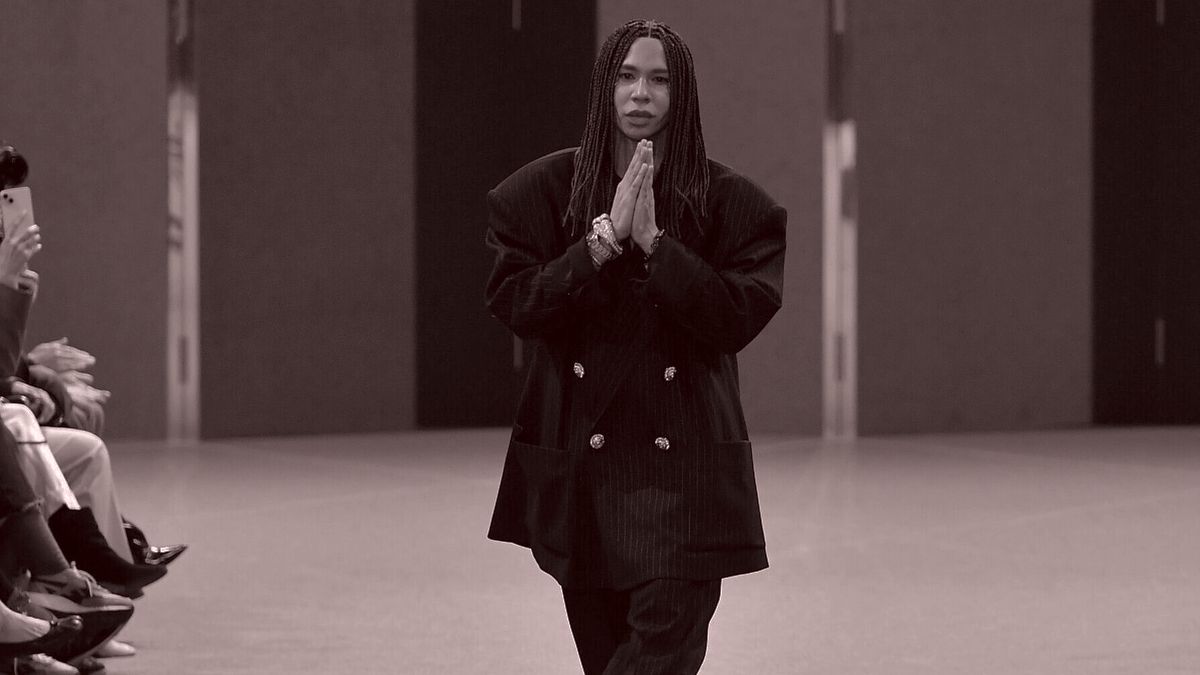Hi, and welcome back to Line Sheet. I just landed in Los Angeles and will be
fully up and running tomorrow. Thanks for all the well-wishes, DMs, and tips sent via various channels while I took a break this past week. And huge thanks to the Puck Central Editing Unit, my beauty-biz queen Rachel Strugatz, and especially our retail renegade Sarah Shapiro for making sure we didn’t miss a beat while I was in Japan.
I’ll probably have something to
say about experiencing luxury goods overseas as Western consumer sentiment crumbled—from LVMH’s revenue miss to DHL’s pausing shipments on goods over $800 to the U.S. For now, though, I’m simply coming to terms with the fact that I had to live through Tuesday twice.
On the agenda today, Sarah “SShapiro@puck.news”
Shapiro is here with a close-up on Levi’s, whose still-new C.E.O., Michelle Gass, is shilling the red tab to a new generation. (I personally love my Levi’s, vintage and new. But especially vintage.) Plus, in the latest what-is-going-on news, did you notice the cost of gold is skyrocketing? I know many of you have, because you’ve told me so, and there was more movement on that
front today. Sarah is also tracking Rent the Runway’s stock slide, Jacquemus’s L.A. store opening, and Mytheresa’s strategic deal with Prada.
Mentioned in this issue: Levi’s, Beyoncé, Chip Bergh, Michelle Gass, the Gold Rush era, Post Malone, Paul Dillinger, Dockers, Dickies, Chris Goble, Beyond Yoga, Nancy Green, Prada,
Jacquemus, Sarah Benady, and many more…
|
|
|
A MESSAGE FROM OUR SPONSOR
|
GET NOTICED
Every detail of the Range Rover Sport has been engineered for exhilarating driving dynamics and spirited
performance.
EXPLORE
|
|
|

|
Sarah Shapiro
|
|
Four Things You Should Know…
|
- Rent the Runway’s stock
slide: Rent the Runway may have successfully stanched its bleeding—cash burn dropped to $6.6 million in fiscal 2024 from $70.5 million the year prior—but last week’s Q1 earnings report didn’t much impress Wall Street, with the stock sliding after a momentary pop. Clearly, investors remain skeptical of the subscription clothing model—especially when RTR is banking on a massive new investment in its inventory to achieve profitability.
As C.E.O. Jennifer
Hyman told me last month, Rent the Runway plans to double the number of units in order to increase the availability of its most popular brands and styles. RTR has been facing formidable competition from Urban’s Nuuly, which is growing faster despite being the second mover in a space that RTR pioneered. Of course, catching up will be expensive: The company is
projecting negative free cash flow of $30 million to $40 million in fiscal 2025 as it sacrifices near-term financials for the promise of growth.
Yes, yes, it’s all very risky: Hyman will be under enormous pressure to solve the fundamental unit economics challenges before Nuuly’s market land grab is complete. Meanwhile, Rent the Runway is possibly in danger of being delisted from the Nasdaq if its stock continues to decline. (It’s fallen nearly 99 percent in less than four years.)
If things don’t work out, its $16 million market cap could be an easy takeover target for a motivated buyer.
- Mytheresa’s Prada play: Mytheresa’s exclusive partnerships just got a little more emozionante, with the online retailer being named the exclusive global distribution partner for Prada. Starting tomorrow, shoppers worldwide can access Prada and Miu Miu through Mytheresa—a significant change for U.S. consumers, who were
previously unable to purchase these brands online, outside of the limited handbag and shoe collections offered on high-end department store websites.
When Prada took the majority—90 percent—of its sales direct, it limited the number of multibrand stores that could sell its goods, especially in the U.S. I know people who used to shop Prada and Miu Miu on Net-a-Porter or MatchesFashion via the Euro sites and have pieces shipped to European hotels during work trips and
holidays.
The Prada deal, which was announced a day before Mytheresa’s acquisition of YNAP (thereby forming LuxExperience), positions the platform as the place to buy the most hard-to-get, expensive goods. Was that the intention of LuxExperience mastermind Michael Kliger? I guess we’ll find out soon. There’s a world in which Mytheresa becomes the Bergdorf Goodman of the group (ultra high-end), and Net-a-Porter turns into the Neiman Marcus… or really, the
Saks Fifth Avenue. Alas, I suppose we’ll find out more soon.
- The gold standard: What’s next for jewelry as the price of precious metals skyrockets? With gold trading around $3,500 an ounce, up more than 30 percent this year to an all-time high, jewelry brands face critical decisions. While traditional luxury houses have the flexibility to raise their prices or elasticize their margin, some emerging designers will likely consider playing with gold
vermeil or other alloys. Others may pivot to mixing in estate jewelry, as one industry source suggested. Many have already raised prices significantly.
The precious metal’s meteoric rise comes at an unusual cultural moment. Gold is both a potent signifier of Trump’s aesthetic and a powerful hedge against his economic policies. Regardless, for some jewelry brands, being able to tout gold jewelry as a savvy investment could be a brilliant Mother’s Day gift.
- Jacquemus’s West Hollywood dream: The French label just announced that its new Los Angeles store—only its second stateside location—is opening later this week. The timing is notable, following L’Oréal’s recent minority stake investment in the brand, which just appointed Sarah Benady, formerly the president of Celine North America, as its new C.E.O. Lauren will be at the opening party, so stay tuned for more…
|
|
|
And now for the main event…
|
|
|
Levi’s is thriving, with a newly surging D.T.C. model, a fitness apparel brand, and a timely
cross-genre partnership with Cowboy Carter, herself. Then again, there’s never been an easier time to sell American jeans. Is Levi’s really meeting the moment, or just getting lucky?
|
|
|
While many in the fashion and retail business are busy debating the revival of mall brands,
one heritage business has been steadily staging its own quiet renaissance—without ever having gone away. The cultural dominance of Levi Strauss & Co., the Gold Rush–era workwear brand, has ebbed and flowed with the times, from disco to low-rise to a hipster preoccupation with Japanese selvidge. But it’s always been the undisputed leader of American denim.
Of course, the company’s stock isn’t quite as impressive as the
brand, with shares trading for about 30 percent below the I.P.O. price in 2019. Nevertheless, the company throws off tons of cash, has a healthy dividend, and surprised to the upside on earnings in its latest quarterly report. Sources credit the transformation strategy started by former C.E.O. Chip Bergh and continued by Michelle Gass, who became C.E.O. last January. Beyond the immediate numbers, however, there’s the longer-term question: How does a 170-year-old
denim pioneer connect with new generations? How much of the brand’s success is the result of its strategy, and how much is owed to a shifting pop culture in which rappers are wrapping themselves in American denim?
|
|
|
A MESSAGE FROM OUR SPONSOR
|
GET NOTICED
Every detail of the Range Rover Sport has been engineered for exhilarating driving dynamics and spirited
performance.
EXPLORE
|
|
|
On the strategic front, Levi’s has made it a point to upgrade their
direct-to-consumer experience—with tech-enabled tailoring and mobile app exclusives—and, as Gass has put it, “transforming into a D.T.C.-first company.” So far, the e-comm push is working: The direct-to-consumer segment has grown steadily as a proportion of the total business since 2015, from 29 percent to 52 percent. Those digital investments have not only driven sales growth, but also significantly
boosted profit margins compared to their traditional wholesale business.
As a result, Levi’s is becoming less and less reliant on wholesale, which now accounts for less than half of the business. With stores in more than 110 countries, the wholesale operation of the world’s leading jeans company is a messy, sprawling management challenge—particularly in Europe, where Levi’s faces increased competition from local brands, different consumer preferences, and a fragmented retail landscape
with partners who lack the digital integration that Levi’s has built internally.
Whereas Levi’s U.S. stores are a mix of owned and franchised locations, they are all franchised in Europe, with the revenue counting as wholesale. (This is yet another reason why net revenue in Europe has been a challenge.) Without control over presentation, assortment, and customer experience in these locations, Levi’s struggles to deliver its usual premium brand
positioning. And while solving this riddle could unlock significant growth, it also ossifies the focus on the brand’s D.T.C. potential.
|
If you went looking for a powerful, impromptu brand ambassador, you could do a lot worse
than Beyoncé, the global genre-bending pop queen who’s been reclaiming her Texas country roots in her Levi’s cutoffs. Levi’s has powerful cultural currency—truly, it’s up there with Coke and Nike among the world’s most recognized brands—but the sight of Beyoncé and Post Malone performing the denim-on-denim song “Levii’s Jeans” during the NFL Christmas Day halftime show was a marketing gift. (Naturally, the company noted the occasion, briefly changing its logo on
Instagram to “Levii’s.”)
The company is poised to take further advantage of the cultural moment. Beyoncé has already had three drops in partnership with the brand, and with her world tour kicking off early next week at SoFi Stadium, I expect lots of Levi’s to be in the crowd—along with plenty onstage. Someone familiar with
the brand told me that Paul Dillinger, Levi’s head of design innovation, has been working on denim for the backup dancers. This is precisely the kind of placement that strengthens the idea of Levi’s, in Gass’s words, as “firmly at the center of culture across the globe.” According to one plugged-in retail source, Taylor Swift’s Eras Tour brought increased revenue for Levi’s in every city she visited, and her tour wasn’t even directly connected to the brand.
|
|
|
But it isn’t all diamonds and denim for Levi’s—there are tensions in the portfolio, too.
Late last year, Levi’s classified its Dockers subbrand as “discontinued operations,” essentially conceding that they intended to explore a sale of the underperforming brand—an end of an era for a once-prominent business casual line. Meanwhile, category competitors like Dickies and Carhartt have been enjoying renewed relevance: Dickies now has Chris Goble, who worked at Gap for more than 18
years, modernizing and reimagining their line. Carhartt has their Work In Progress (or WIP) collection, which, while a small part of the business compared to its traditional workwear, is enough to give them fashion cred that Dockers (a punch line, even if a profitable one) never achieved.
Tariff-related uncertainty has also complicated the valuation process for Dockers, I’m told. But Gass’s decision
to engage with potential buyers, and to make difficult decisions about culling Levi’s portfolio, speaks to her willingness to refocus the business on areas where the growth potential is the most significant. (It helps that less than 2 percent of Levi’s products are now produced in China, compared to 16 percent in 2017—the result of a deliberate diversification strategy initiated by Bergh.)
On the opposite end of Levi’s portfolio spectrum is
Beyond Yoga, the supersoft, size-inclusive activewear brand that Levi’s acquired for $400 million in 2021 in order to diversify beyond denim (and grab market share with women). The brand has shown impressive momentum, growing 10 percent in Q1 and now doing more than $125 million annually under the direction of newish C.E.O. Nancy Green (formerly of Old Navy and Athleta).
While
activewear remains in growth mode, the acquisition strategy deserves scrutiny. With core denim business showing renewed vigor, should leadership divert attention and resources to building secondary brands? The Beyond Yoga business is vastly different from Levi’s—in fabrication, marketing, creativity, sourcing, and factory relationships and wholesale accounts. Currently, Beyond Yoga has seven store locations, five of which are in California. To build brand awareness they will need to expand to
more store locations.
In any case, Levi’s has a solid story to tell right now, even if the stock is lacking similar narrative momentum. The company’s leadership deserves credit for dramatically expanding margins to 62.1 percent—far above Gap Inc. (38.9 percent in Q1), American Eagle Outfitters (37.3 percent), and Kontoor Brands, which owns Wrangler and Lee (44.5 percent at the end of 2024). That strength derives from Levi’s
robust D.T.C. channels, supply chain management, and operational efficiency, and from not being overly reliant on markdowns. Whether Gass can successfully offload the Dockers brand and build up Beyond Yoga without distracting from the core business will be the key to continued success.
|
Until tomorrow,
Lauren
P.S.: We are using
affiliate links because we are a business. We may make a couple bucks off them.
|
|
|
Puck fashion correspondent Lauren Sherman and a rotating cast of industry insiders take you deep behind the scenes of this
multitrillion-dollar biz, from creative director switcheroos to M&A drama, D.T.C. downfalls, and magazine mishaps. Fashion People is an extension of Line Sheet, Lauren’s private email for Puck, where she tracks what’s happening beyond the press releases in fashion, beauty, and media. New episodes publish every Tuesday and Friday.
|
|
|
Need help? Review our FAQ page or contact us for assistance. For brand partnerships, email ads@puck.news.
You received this email because you signed up to receive emails from Puck, or as part of your Puck account associated with . To stop receiving this newsletter and/or manage all your email preferences, click here.
|
Puck is published by Heat Media LLC. 107 Greenwich St, New York, NY 10006
|
|
|
|















